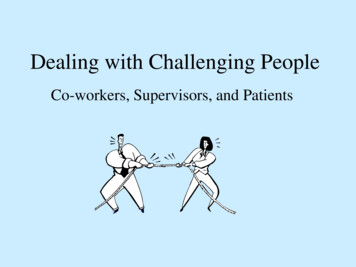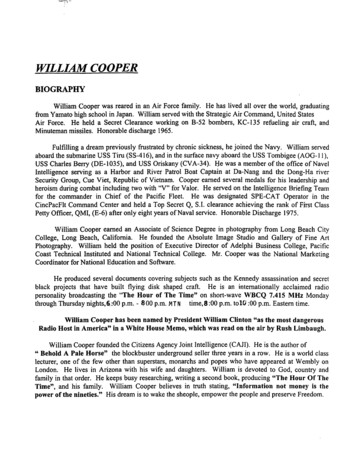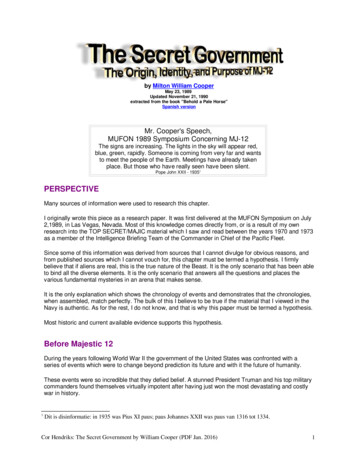
Transcription
Dealing with Challenging PeopleCo-workers, Supervisors, and Patients
Objectives To identify the characteristics of challengingpeople. To recognize what makes you challenging attimes. To understand your response to challengingpeople. To learn tools for dealing with thosechallenging people more effectively.
What are the characteristics thatmake someone challenging foryou?
What makes youchallenging at times?
Who’s the challenging personnow? Name a challenging person. Be specific about what makes that personchallenging. Identify how you usually respond to that person. Consider why they might be behaving that way Determine what you would like to happendifferently from them and from you.
Goals of Dealing withChallenging People To hear and be heard!Get the job done!Neutralize the situation, don’t escalate it.Don’t take it personally!
What gets in our way ofcommunicating effectively?
Barriers to Communication leTimeEnvironment
Behavioral Barriers OrderingIgnoringSarcasmMoralizing/judgingName callingFalse reassurance
Communication StylesPassiveAggressiveAssertive
PassiveGoal: To please, to be liked, to avoid conflict.Resulting Feelings: Anxious, ignored, hurt,manipulated, disappointed in themselves,angry and resentful.Benefits: To avoid unpleasant situations,short-term tensions and confrontations.Costs: Get taken advantage of and don’t gettheir needs met.
AggressiveGoal: To win, dominate, assert power, tocontrol and sometimes to humiliate.Resulting Feelings: Self-righteous,controlling, superior and sometimesembarrassed later.Benefits: Release anger, have control and gettheir way.Costs: Alienate others.
AssertiveGoal: To give and receive respect whilemaking known opinions, wants or feelings.Resulting Feelings: Confidence and success.Feel good about themselves and are incontrol.Benefits: Get needs met while maintainingpositive relationships.Costs: Sometimes, time.
Active Listening Body language – eye contact, posture, headnod Reflection – “So what I heard you saywas ” Empathy – “I can tell you are feeling ” Clarification – “Did you mean when yousaid ” or “Help me understand better”
Assertive Communication Skills “I” statement: “I think/feel/believe ” Two-part message: “I think/feel/believewhen you ” Empathic message: “I understand you arefeeling and ” Request statement: “ and what I needfrom you is ”
The Power of “AND”“BUT” must go -- Kick it right outof your vocabulary.“But” makes the statement:JudgmentalLip service for the first part of statementInsincerePatronizing
All Together Now, 1 2 3 1) I am sorry this is so upsetting to you2) AND3) Let’s find a way to make it better.1) I hear you both feel you were treated unfairly2) AND3) Let’s agree that both of you stop arguing.
And more about1. String together as many “AND’s” as you need2. Pause between “AND’s” so the person absorbsyour empathy and connection3. Empathy and understanding is sometimes all aperson wants and all we have to give.4. It’s stating I can understand this for YOU.“I know this is difficult and you doubt it will get better andwe just need to do one more test and we will be as gentle aspossible.”
And 1, 2, 3 1) I know you expected the report on time2) AND3) We had an emergency.1) I can see you are worried about your family2) AND3) We will have that information shortly
Phrases to Avoid Threatening: “If” followed by “You” Blaming/Shaming: “Why” followed by“Can’t,” “Won’t” or “Don’t” Labeling: “Never,” “Ever,” and “Always” Generalizing: “You” followed by a negativenoun, adjective, or phrase Discounting: Using the word “but”
3 Quick & Easy Rules1. You can’t apply the Golden Rule becausechallenging people won’t necessarily treatyou the way you would treat them.2. Stop using the Old American method.Speaking louder will not get them tounderstand better.3. Try something. Anything, noticeablydifferent.
Do’s and Don’ts for Dealing withthe Different Types of ChallengingPeople
Hostile Aggressive Bully and bombard to get their wayRaised voiceIntimidating body languageProfanity
Hostile AggressiveDo’sDon’ts Stay calm/take deepbreaths Stop the interactiontemporarily Communicate that youwould like to hearwhat they have to say,but not like this Stand your ground Counter attack Get defensive Shut down orwithdraw Take it personally
Indirect Hostile Aggressive Use sarcasm Put opponents down Back-stab
Indirect Hostile AggressiveDo’sDon’ts Ask for clarification– Intent – “When you saythat, what are you reallytrying to say?”– Relevancy – “What doesthat have to do with this?” Suggest that, in the future,if there is a problem, cometalk one-on-one. React Take it personally Lash out
Expert/Know-It-All Their way is the only way Arrogant Inflexible
Know-It-AllDo’sDon’ts Be prepared Present newinformation with facts Use pronouns like“we” and “us” Be flexible Turn them into amentor Become a know-it-allyourself Get defensive
Think They Know-It-All InsecureStubbornOver-explainDefensive
Think They Know-It-AllDo’sDon’ts Recognize theirinsecurity Have compassion Give them a littleattention Ask them to help youunderstand theirposition Be judgmental Be too blunt
Indecisive Listen well Can’t make decisions Don’t complete tasks
IndecisiveDo’s Be specific andconcrete about whatyou want Limit choices Be patientDon’ts Get angry Make the decision forthem
Super-Agreeable Want to be liked Agree regardless of theiropinion Often don’t complete tasks
Super-AgreeableDo’sDon’ts Let them know thatdisagreeing is okay Be specific about whatyou want from them Ask for negatives Make them feel shame Avoid conflict becausethey are too nice
Complainer/Negativist WhineOppositionalResistant to changeFeel powerless
Complainer/NegativistDo’sDon'ts Listen andacknowledge whatthey say Consider theirperspective Focus on problemsolving Separate from thenegativity Argue Expect them to change Agree
Silent/Unresponsive Say nothing Avoid conflict
Silent/UnresponsiveDo’sDon’ts Start the conversation Ask open-endedquestions Slow down If no response, stateyour plan Show frustration Lose your temper
Now that you know what typesof people push your buttons
Let’s try out your new skills
Remember, you can not controlother people’s behavior, you canonly control how you choose torespond!
And maybe you can influencehow they behave with you!
1. You can’t apply the Golden Rule because challenging people won’t necessarily treat you the way you would treat them. 2. Stop using the Old American method. Speaking louder will not get them to understand










